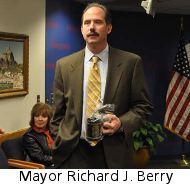10/26/2010
New Mexico: Study Shows Photo Enforcement Increased AccidentsStudy shows total accidents increased slightly where combination red light speed cameras were used in Albuquerque, New Mexico.

Photo enforcement cameras are temporarily disabled in Albuquerque, New Mexico after a study by the University of New Mexico failed to offer a complete justification for the program. Mayor Richard J. Berry announced that he would eliminate six of the twenty red light camera intersections where accidents increased the most. He also will stop issuing speed camera citations at intersections -- although he plans to keep three vans to set up mobile photo radar traps. While the contract with Redflex Traffic Systems is expired, Berry is seeking a better deal from other photo ticketing vendors.
Albuquerque started the automated enforcement program with a pair of red light cameras in 2004 and gradually expanded to cover both speed and red light tickets at twenty intersections (although three locations were shut down by the state in May). The combination has resulted in the mailing of 527,250 citations, each worth between $100 and $400. Total revenue exceeded $37,931,000 with another $5,676,000 expected in fiscal 2011. Of this amount, Redflex has taken home $15,947,000 with another $3,498,000 expected in 2011.
With that much money at stake, the study, which was funded by the city of Albuquerque, presented automated enforcement as favorable a light as it could. The study measured the number of accidents in thirty-eight camera-free control intersections used for comparison with the twenty photo-enforced intersections. The total number of crashes at the photo enforced intersections increased while camera-free intersections saw a decrease. While injury accidents decreased at the camera intersections, the decrease was much more prominent, 29 percent, at camera-free locations.
Location Total Crashes Injury Property Damage Camera Intersection +3.5 -18.2 +13.2 No Cameras -9.9 -29.0 +0.3
The report dismissed the increase in the overall number of crashes by providing an accident cost analysis not based on any examination of the collisions in Albuquerque, but by applying a generic formula designed to downplay the importance of rear end collisions. The report recommended that the city use engineering countermeasures to improve safety. Mayor Berry issued a statement confirming his willingness to do so -- including giving drivers longer yellow times.
"I have asked the city's municipal development director to look at ways to improve these intersections with better traffic engineering, signage, adjustments to the length of yellow lights and enhanced signalization," Berry said.
A copy of the full study is available in a 2mb PDF file at the source link below.


